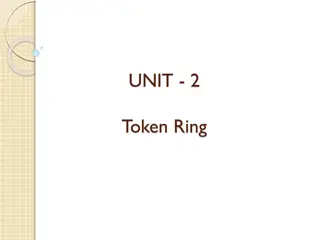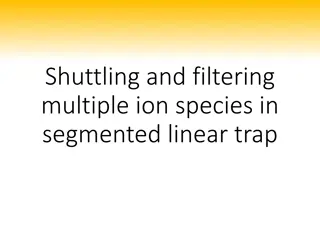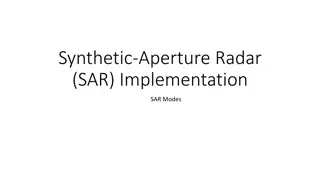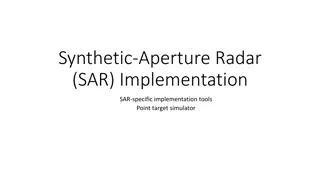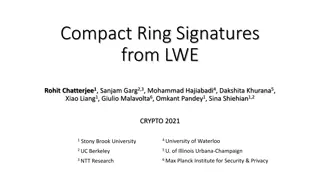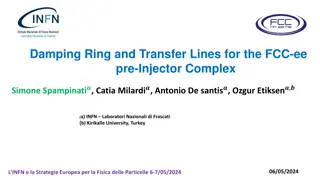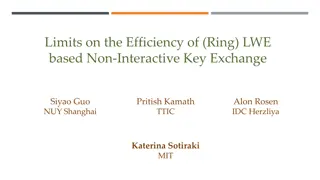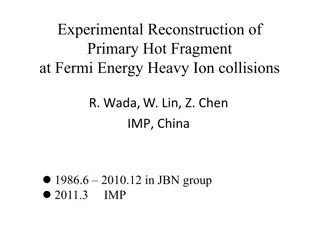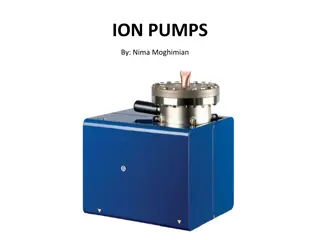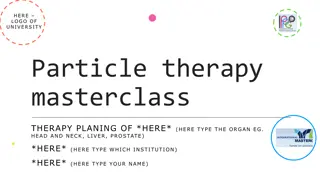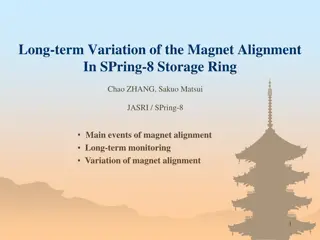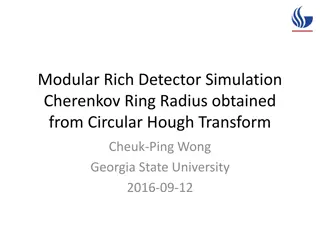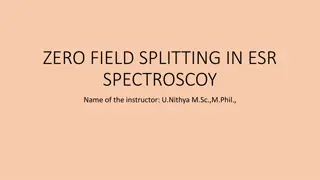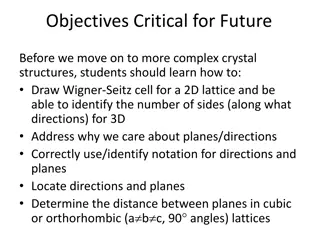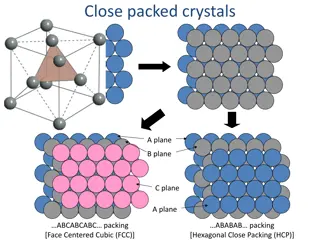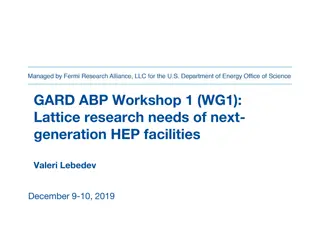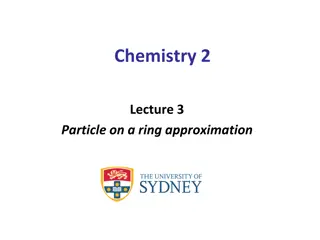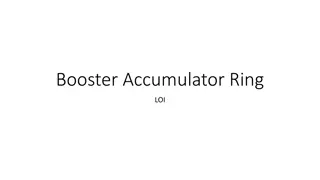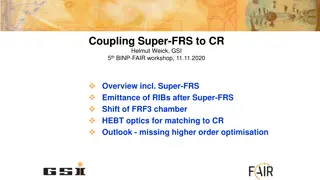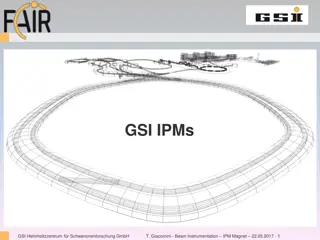Dynamic Aperture Study for Ion Ring Lattice Optimization
This study focuses on optimizing the dynamic aperture of the ion ring lattice, covering topics such as correct chromaticity, aperture scanning, effects of alignment and field errors, and correction procedures. The comparison of various lattice schemes provides insights into aperture characteristics, chromatic tunes, and beam dynamics of non-interleaved ion pairs.
Download Presentation

Please find below an Image/Link to download the presentation.
The content on the website is provided AS IS for your information and personal use only. It may not be sold, licensed, or shared on other websites without obtaining consent from the author. Download presentation by click this link. If you encounter any issues during the download, it is possible that the publisher has removed the file from their server.
E N D
Presentation Transcript
Dynamic Aperture Study for the Ion Ring Lattice Options Min-Huey Wang, Yuri Nosochkov MEIC Collaboration Meeting Fall 2015 Jefferson Lab, Newport News, VA Oct. 5, 2015
Outlines Optimization of on and off momentum dynamic aperture of bare lattice Correct linear chromaticity, correct Wx/Wy to zero at IP. Using tune trombone to maximize the range of chromatic tunes. Using tune trombone to scan the dynamic aperture versus tune. Effects of alignment and field errors Correction procedures Dynamic aperture after correction Effects of Magnet Multipole Field Errors Dynamic aperture reduction due to multiple field errors
Global tune scan using tune trombone X: 24.01 y :23.15 X: 24.10 y :23.15 X:24.24 y :23.15 Choosing Fractional x :0.22 y :0.16 X: +1 y :+1
Chromatic tunes Interleaved I pairs Non-interleaved I pairs Interleaved I pairs with beta beat CCB
Chromatic * Non-interleaved I pairs Interleaved I pairs Interleaved I pairs with beta beat CCB
Bare lattice dynamic aperture Interleaved I pairs Non-interleaved I pairs Interleaved I pairs with beta beat CCB
Comparison for bare lattice Scheme Non-interleaved I pairs 24.22/23.16 -111.5, -131. +1, +1 7.82E2/1.88E3 -1.50E6/-1.06E6 1.93E3 1.78E3 -6.7E1 8 48 0.414 0.598 1.55/1.00 1.22/0.86 0.89/0.69 (-) 0.22/0.635 (-) Interleaved I w/o beta beat 24.22/24.16 -101.5, -112.2 +1, +1 4.6E3/-4.2E3 -2.4E6/-2.96E6 6.08E+03 1.12E+03 -3.04E+03 36 32 1.39 1.492 0.8/0.55 0.61/0.42 0.38/0.2 (-) -------- (+) Interleaved I with beta beat 24.22/24.16 -105.4, -130.6 +1, +1 1.5E3/1.39E3 -1.11E6/-1.39E6 4.36E+02 1.74E+03 -5.68E+03 24 48 0.65 0.389 1.15/0.40 0.88/0.33 0.66/0.38 (-) 0.64/0.32 (-) CCB* 25.22/23.16 -120/-119 +1, +1 7.29E1/2.00E2 -1.2E6/-1.52E6 1.15E+01 1.01E+02 -1.26E+04 6 48 0.37 0.485 0.92/0.27 0.97/0.27 0.52/0.21 (+) 0.32/0.14 (+) Tune, (x,y) Natural chromaticity (x,y) 1 = d /d p (x,y) 2 = d /d p2 (x,y) 3 = d /d p3 (x,y) d x/dJx d y/dJy d y/dJx Nonlinear chrom sextupoles Linear chrom sextupoles Max K2L (nonlinear sext), m-2 Max K2L (linear sext), m-2 DA at p = 0 (x/y), mm DA at p = 0.1% (x/y), mm DA at p = 0.2% (x/y), mm DA at p = 0.3% (x/y), mm *Lattice named MEIC_P_RING_V15C.1_CCB_V3_TRACK_16JUN15 from Vasiliy, not updated.
Beam dynamics of non-interleaved I pairs DA frequency map Tune foot print Qx = 24.22 Qy = 23.16 Blue 5th XN=0.35E-6, yN=0.07E-6 Magenta 6th X,ip=0.1 m y,ip=0.02 m E= 60 GeV X,ip= 23.4 m y,ip= 4.7 m Chromatic tune Amplitude dependent tune 24.25 24.24 24.23 x 24.22 24.21 -1.5 -1 -0.5 0 0.5 1 1.5 x(mm) 23.19 23.18 y 23.17 23.16 0 0.2 0.4 0.6 0.8 1 y(mm)
Effects of alignment error and field error The alignment error and field error are provided by Guohui. s misalignment it s not included in LEGO. The errors of final focus quads are different. There are total 178 H/V correctors and 199 H/V monitors for orbit correction. Using QSFB01, QSFB02 for tune correction. Using SXT01R, SXT02R for linear chromaticity correction. Table of alignment and field errors Dipole Quadrupole Sextupole FFQ BPM(noise) Corrector x misalignment(mm) 0.1 0.1 0.1 0.01 0.02 - y misalignment(mm) 0.1 0.1 0.1 0.01 0.02 - x-y rotation(mrad) 0.1 0.1 0.1 0.05 - 0.1 s misalignment(mm) 0.0 0.0 0.0 0.0 - - Strength error(%) 0.01 0.1 0.1 0.01 - 0.01
Correction scheme Correct orbit in both planes Correct coupling (w/o skew quadrupole) steer orbit Correct chromaticity, correct tune Correct beta beat in both planes correct betax/y, correct tune Correct chromaticity, correct tune Correct vertical dispersion steer vertical orbit Correct chromaticity, correct tune Do the above correction several iterations. (for example 4 times) check the final orbit check the final tune and chromaticity check the final beta beat check the final coupling For every random seed the error can be divided into several steps if the effect of error is too large. (10 steps for example).
Alignment error and field error with correction Dynamic aperture can be restored after all the corrections Correction result of one random seed, total 10 random seeds. Rms of final horizontal orbit: 1.68E-01 mm Rms of final vertical orbit: 1.62E-01 mm FINAL BETA BEAT Rms of final horizontal beta beat is: 3.80E-02 Rms of final vertical beta beat is: 3.94E-02 FINAL COUPLING Rms of final coupling is: 4.96E-02 Dynamic aperture Bare lattice Alignment errors with corrections 1 0.8 y (mm) 0.6 0.4 0.2 0 -2 -1.5 -1 -0.5 0 0.5 1 1.5 2 x (mm)
Orbit after correction Orbit at IP 0.5 Horizontal orbit (mm) 0 -0.5 0 500 1000 1500 2000 BPM position (m) 0.5 Vertical orbit (mm) 0 -0.5 0 500 1000 1500 2000 BPM position (m) Orbits after correction of 10 random seeds
Corrector strength 0.04 0.02 HCOR (mrad) 0 -0.02 -0.04 0 500 1000 1500 2000 HCOR position (m) 0.04 0.02 VCOR (mrad) 0 -0.02 -0.04 0 500 1000 1500 2000 VCOR position (m) Corrector strength of 10 random seeds
Effects of magnet multipole field errors Check the effects of multipole field (MP) error of magnet at different region (beta function). No MP errors of FF quads No MP errors of magnet at beta function larger than 500 m. MP in arc sections only. Double check with elegant Check the effects of different harmonics of multipole field on dynamic aperture in arc
Magnet multipole tolerances (from PEPII study) The magnet multipole tolerance is defined relative to the field component normalized at a reference radius r: ?? ?? (? 1)! ?(? 1) (? 1)! ?(? 1) ?? ? ,?(? 1) = ?? 1? ?? 1 ? = Multipole errors of dipole at radius 30 mm ?3 ?1 ?1 1.0e 5 3.2e 5 3.2e 5 6.4e 5 Multipole errors of quadrupole at radius 44.9 mm ?3 ?2 ?2 1.03e 3 5.6e 4 4.8e 4 5.6e 4 4.5e 4 1.9e 4 Multipole errors of sextupole at radius 56.52 mm ?5 ?3 ?3 1.45e 2 2.2e 3 1.05e 3 multipole type systematic rms ?4 ?5 ?1 ?6 ?1 8.2e 5 multipole type systematic rms ?4 ?5 ?2 ?6 ?2 ?10 ?2 ?14 ?2 2.37e 3 1.7e 4 -3.10e 3 1.8e 4 -2.63e 3 7.0e 7 multipole type systematic rms ?7 ?9 ?3 ?15 ?3 1.3e 2
Non-interleaved I pairs (no FF Quad MP errors) Dynamic aperture Bare lattice MP w/o FF Quad 0.2 0.15 Dynamic aperture y (mm) 0.12 Bare lattice MP all 0.1 0.1 0.08 y (mm) 0.05 0.06 0.04 0.02 0 -0.5 0 0.5 -0.1 0 x (mm) -0.2 -0.15 -0.05 0 0.05 0.1 0.15 0.2 x (mm)
Non-interleaved I pairs ( no MP errors@ x,y > 500m) Dynamic aperture 0.25 Bare lattice MP x,y < 500 m 0.2 0.15 y (mm) 0.1 0.05 0 -0.5 0 0.5 x (mm)
Non-interleaved I pairs ( MP errors in Arcs) Dynamic aperture Bare lattice Arc MP errors 1 0.8 0.6 y (mm) 0.4 0.2 0 -1.5 -1 -0.5 0 0.5 1 1.5 x (mm)
Dynamic aperture with MP errors using elegant no FF Quad MP errors no MP errors@ bx,y > 500m Tracking dynamic aperture with 50 random seeds using elegant. The horizontal aperture is similar as LEGO result, the vertical aperture all larger than LEGO result. MP errors in Arcs
Systematic + rms single MP term in Arcs Dynamic aperture Dynamic aperture Dynamic aperture Bare lattice Arc quad B3 Bare lattice Arc quad B4 Bare lattice Arc bend B3 1 1 1 0.8 0.8 0.8 y (mm) y (mm) y (mm) 0.6 0.6 0.6 Dipole B3 Quad B3 Quad B4 0.4 0.4 0.4 0.2 0.2 0.2 0 0 0 -1.5 -1 -0.5 0 0.5 1 1.5 -1.5 -1 -0.5 0 0.5 1 1.5 -1.5 -1 -0.5 0 0.5 1 1.5 x (mm) x (mm) x (mm) Dynamic aperture Dynamic aperture Dynamic aperture Bare lattice Arc quad B5 Bare lattice Arc quad B6 Bare lattice Arc quad B3 1 1 1 0.8 0.8 0.8 y (mm) y (mm) y (mm) 0.6 0.6 0.6 Quad B5 Quad B6 Quad B10 0.4 0.4 0.4 0.2 0.2 0.2 0 0 0 -1.5 -1 -0.5 0 0.5 1 1.5 -1.5 -1 -0.5 0 0.5 1 1.5 -1.5 -1 -0.5 0 0.5 1 1.5 x (mm) x (mm) x (mm) Dynamic aperture Dynamic aperture Dynamic aperture Bare lattice Arc quad B14 Bare lattice Arc sext B9 Bare lattice Arc quad B14 1 1 1 0.8 0.8 0.8 y (mm) y (mm) y (mm) 0.6 0.6 0.6 Sext B9 Sext B16 Quad B14 0.4 0.4 0.4 0.2 0.2 0.2 0 0 0 -1.5 -1 -0.5 0 0.5 1 1.5 -1.5 -1 -0.5 0 0.5 1 1.5 -1.5 -1 -0.5 0 0.5 1 1.5 x (mm) x (mm) x (mm) Individual term does not affect dynamic aperture The cancelation of MP effect may due to the periodicity of FODO cell in arc
Systematic term add on 1.4 1.4 1.4 Dipole B3 Quad B3 Quad B4 1.2 1.2 1.2 1 1 1 0.8 0.8 0.8 0.6 0.6 0.6 0.4 0.4 0.4 0.2 0.2 0.2 0 0 0 -2 -1.5 -1 -0.5 0 0.5 1 1.5 2 -2 -1.5 -1 -0.5 0 0.5 1 1.5 2 -2 -1.5 -1 -0.5 0 0.5 1 1.5 2 1.4 1.4 1.4 Quad B5 Quad B6 Quad B10 1.2 1.2 1.2 1 1 1 0.8 0.8 0.8 0.6 0.6 0.6 0.4 0.4 0.4 0.2 0.2 0.2 0 0 0 -2 -1.5 -1 -0.5 0 0.5 1 1.5 2 -2 -1.5 -1 -0.5 0 0.5 1 1.5 2 -2 -1.5 -1 -0.5 0 0.5 1 1.5 2 1.4 1.4 1.4 Sext B9 Sext B16 Quad B14 1.2 1.2 1.2 1 1 1 0.8 0.8 0.8 0.6 0.6 0.6 0.4 0.4 0.4 0.2 0.2 0.2 0 0 0 -2 -1.5 -1 -0.5 0 0.5 1 1.5 2 -2 -1.5 -1 -0.5 0 0.5 1 1.5 2 -2 -1.5 -1 -0.5 0 0.5 1 1.5 2 Add on the systematic MP error term from Dipole to sextupole, low order to high order
Systematic plus rms term add on 1.4 1.4 1.4 System + skew Quad B3 Quad B4 1.2 1.2 1.2 1 1 1 0.8 0.8 0.8 0.6 0.6 0.6 0.4 0.4 0.4 0.2 0.2 0.2 0 0 0 -2 -1.5 -1 -0.5 0 0.5 1 1.5 2 -2 -1.5 -1 -0.5 0 0.5 1 1.5 2 -2 -1.5 -1 -0.5 0 0.5 1 1.5 2 1.4 1.4 1.4 Quad B5 Quad B6 Quad B10 1.2 1.2 1.2 1 1 1 0.8 0.8 0.8 0.6 0.6 0.6 0.4 0.4 0.4 0.2 0.2 0.2 0 0 0 -2 -1.5 -1 -0.5 0 0.5 1 1.5 2 -2 -1.5 -1 -0.5 0 0.5 1 1.5 2 -2 -1.5 -1 -0.5 0 0.5 1 1.5 2 1.4 1.4 1.4 Sext B9 Sext B16 Quad B14 1.2 1.2 1.2 1 1 1 0.8 0.8 0.8 0.6 0.6 0.6 0.4 0.4 0.4 0.2 0.2 0.2 0 0 0 -2 -1.5 -1 -0.5 0 0.5 1 1.5 2 -2 -1.5 -1 -0.5 0 0.5 1 1.5 2 -2 -1.5 -1 -0.5 0 0.5 1 1.5 2 Add on the rms MP error term from Dipole to sextupole, low order to high order
Dynamic aperture with MP correction in arc Dynamic aperture Dynamic aperture Bare lattice Arc MP errors correction to B4 Bare lattice Arc MP errors correction to B6 1 1 0.8 0.8 y (mm) y (mm) 0.6 0.6 0.4 0.4 0.2 0.2 0 0 -1.5 -1 -0.5 0 0.5 1 1.5 -1.5 -1 -0.5 0 0.5 1 1.5 x (mm) x (mm) Assuming the MP error can be corrected by implanting higher order magnets The dynamic aperture reduction of MP errors in arc is due to B5 and B6 terms, which is consistent with the resonances seen in tune foot print.
Conclusion Among all of the four ion ring lattices the non-interleaved I pairs gives the best dynamic aperture The dynamic aperture can be restored under current misalignment and field error budget with orbit, tune, chromaticity, coupling, bata beat and vertical dispersion corrections. Big dynamic aperture reduction due to multiple field errors of I pairs lattice. To restore the dynamic aperture reduction due to multiple field errors Adding MP correction components Modified the MP field tolerance table Move working tune to enlarge resonance free tune space.






